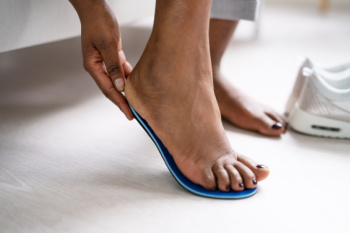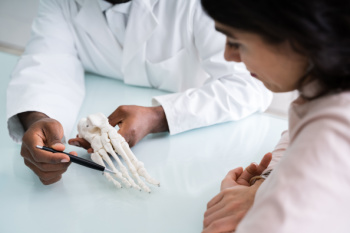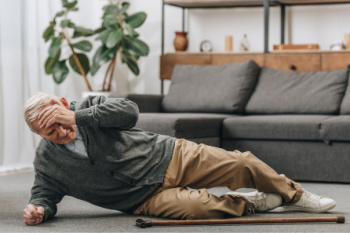Connect With Us
Blog
Items filtered by date: December 2022
Back of the Ankle Pain Experienced by Dancers

Pain at the back of a dancer’s ankle can happen for various reasons, ranging from overuse to specific injuries. Achilles tendonitis, a common condition among dancers, results from repetitive stress on the Achilles tendon, leading to inflammation and discomfort. Another possible cause is posterior impingement syndrome, often seen in dancers who frequently point their toes, causing compression and irritation at the back of the ankle joint. Additionally, Haglund's deformity, characterized by a bony prominence at the back of the heel, can exacerbate discomfort, especially when wearing tight-fitting shoes. If you are a dancer and are experiencing ankle pain, it is suggested that you schedule an appointment with a podiatrist for an accurate diagnosis and effective treatment.
Ankle pain can have many different causes and the pain may potentially be serious. If you have ankle pain, consult with Afsha Naimat-Shahzad, DPM from Leander Foot & Ankle. Our doctor will assess your condition and provide you with quality foot and ankle treatment.
Ankle pain is any condition that causes pain in the ankle. Due to the fact that the ankle consists of tendons, muscles, bones, and ligaments, ankle pain can come from a number of different conditions.
Causes
The most common causes of ankle pain include:
- Types of arthritis (rheumatoid, osteoarthritis, and gout)
- Ankle sprains
- Broken ankles
- Achilles tendinitis
- Achilles tendon rupture
- Stress fractures
- Tarsal tunnel syndrome
- Plantar fasciitis
Symptoms
Symptoms of ankle injury vary based upon the condition. Pain may include general pain and discomfort, swelling, aching, redness, bruising, burning or stabbing sensations, and/or loss of sensation.
Diagnosis
Due to the wide variety of potential causes of ankle pain, podiatrists will utilize a number of different methods to properly diagnose ankle pain. This can include asking for personal and family medical histories and of any recent injuries. Further diagnosis may include sensation tests, a physical examination, and potentially x-rays or other imaging tests.
Treatment
Just as the range of causes varies widely, so do treatments. Some more common treatments are rest, ice packs, keeping pressure off the foot, orthotics and braces, medication for inflammation and pain, and surgery.
If you have any questions, please feel free to contact our office located in Leander, TX . We offer the newest diagnostic and treatment technologies for all your foot care needs.
Foot Orthotics
Orthotics are shoe inserts that are meant to correct an irregular walking gait or provide cushioning to the feet. Orthotics come in a variety of different models and sizes, including over-the-counter and customizable variants. Customizable orthotics can be shaped and contoured to fit inside a specific shoe and are typically prescribed through a podiatrist who specializes in customized footwear and orthotics design and management.
Orthotics are beneficial because they can help prevent injuries from occurring and provide cushioning to keep pain levels down to a minimum. They also allow for the correct positioning of the feet. Orthotics can act as shock absorbers to help remove pressure from the foot and ankle. Therefore, orthotics can make bodily movements, such as walking and running, become more comfortable as well as help prevent the development of certain foot conditions.
Orthotics alleviate pain and make the foot more comfortable by slightly altering the angle at which the foot strikes the ground surface, therefore controlling the movement of the foot and ankle. Orthotics come in different variants and can be made of various materials. To determine what type of orthotic is most suited to your feet and your needs, it is best to consult your podiatrist. He or she will be able to recommend a type of orthotic that can help improve your foot function or prescribe a custom orthotic to best fit your feet.
Orthotics Can Help in Plantar Fasciitis Treatment

Orthotics are a common treatment for plantar fasciitis, a condition causing persistent heel and foot pain. These shoe inserts provide support and alignment correction, relieving pressure on the plantar fascia. By redistributing weight and reducing strain on the foot's arch, orthotics can help to alleviate discomfort and promote healing. They are designed to address specific imbalances during walking or standing, improving overall foot mechanics. Studies have shown that orthotics can effectively reduce pain and improve function for individuals suffering from plantar fasciitis. Custom-made orthotics are particularly effective at offering tailored support for individual foot shapes and conditions. In addition to other treatments, such as stretching exercises and wearing proper footwear, orthotics can help in managing and alleviating plantar fasciitis symptoms. If you suffer from the discomfort of plantar fasciitis, it is suggested that you schedule an appointment with a podiatrist who can determine the most suitable treatment for you, including custom-made orthotics as an option.
If you are having discomfort in your feet and would like to try orthotics, contact Afsha Naimat-Shahzad, DPM from Leander Foot & Ankle. Our doctor can provide the care you need to keep you pain-free and on your feet.
What Are Orthotics?
Orthotics are inserts you can place into your shoes to help with a variety of foot problems such as flat feet or foot pain. Orthotics provide relief and comfort for minor foot and heel pain but can’t correct serious biomechanical problems in your feet.
Over-the-Counter Inserts
Orthotics come in a wide variety of over-the-counter inserts that are used to treat foot pain, heel pain, and minor problems. For example, arch supports can be inserted into your shoes to help correct overarched or flat feet, while gel insoles are often used because they provide comfort and relief from foot and heel pain by alleviating pressure.
Prescription Orthotics
If over-the-counter inserts don’t work for you or if you have a more severe foot concern, it is possible to have your podiatrist prescribe custom orthotics. These high-quality inserts are designed to treat problems such as abnormal motion, plantar fasciitis, and severe forms of heel pain. They can even be used to help patients suffering from diabetes by treating foot ulcers and painful calluses and are usually molded to your feet individually, which allows them to provide full support and comfort.
If you are experiencing minor to severe foot or heel pain, it’s recommended to speak with your podiatrist about the possibilities of using orthotics. A podiatrist can determine which type of orthotic is right for you and allow you to take the first steps towards being pain-free.
If you have any questions please contact our office located in Leander, TX . We offer the newest diagnostic and treatment technologies for all your foot and ankle needs.
What is a Podiatrist?
A podiatrist is a Doctor of Podiatric Medicine who treats the foot, ankle, and related structures of the leg. If you are having any pain, injuries, or abnormalities in these areas, it is best that you seek help from a podiatrist.
Podiatrists complete four years of training in a podiatric medical school. Their training is like that of other physicians, and they may go on to complete a fellowship training after a residency training. Some podiatrists are board certified meaning they have advanced training, clinical experience, and have taken an exam to prove their skills. Certifying boards for podiatry are the American Board of Foot and Ankle Surgery and the American Board of Podiatric Medicine. Podiatrists may work in private practices, hospitals, clinics, or they may even become professors at colleges of podiatric medicine.
While in college, those who want to be podiatrists often take biology, chemistry, and physics classes in preparation for podiatry school. In podiatry school, students study how the bones, nerves, and muscles work together to help you move around. Additionally, they study injuries and how to properly diagnose and treat them. Admittance into podiatric medical school requires the completion of 90 semester hours of undergraduate study with a good grade point average, and acceptable scores on the MCAT (Medical College Admission Test)
Podiatrists treat many different conditions such as: aching feet, ankle pain, bunions, corns, hammertoes, fungus, ingrown toenails, plantar fasciitis, sprains and more. Common forms of treatment for these conditions are physical therapy, drugs, or surgery. Podiatrists may also recommend corrective shoe inserts, custom-made shoes, plaster casts, and strappings to correct deformities.
Even if you are someone whose feet are in generally good condition, you should still visit a podiatrist to have your feet properly exfoliated and maintained, or to make sure you are looking after your feet properly.
How Podiatrists Help Patients Manage Chronic Foot Pain
 Podiatrists play an important role in managing chronic foot pain. Podiatrists can diagnose the underlying causes of the pain and also implement targeted treatment plans. These doctors have the specialized knowledge it takes to pinpoint the source of the foot pain, whether it be caused by structural issues, biomechanical abnormalities, or conditions such as arthritis or neuropathy. They may perform assessments and diagnostic tests to find the answers patients in pain are looking for. Based on the diagnosis, podiatrists may recommend a variety of interventions to ease pain, including custom orthotic inserts to correct foot alignment, stretches to strengthen muscles and improve flexibility, or corticosteroid injections to reduce inflammation and alleviate pain. Podiatrists can also provide guidance on proper footwear selection and offer lifestyle modifications to minimize stress on the feet. By addressing the root cause of chronic foot pain and tailoring treatment plans to individual needs, podiatrists empower patients to find relief and regain mobility, which can greatly enhance quality of life. If you have persisting foot pain, it is suggested that you visit a podiatrist who can diagnose you and provide a personalized treatment plan.
Podiatrists play an important role in managing chronic foot pain. Podiatrists can diagnose the underlying causes of the pain and also implement targeted treatment plans. These doctors have the specialized knowledge it takes to pinpoint the source of the foot pain, whether it be caused by structural issues, biomechanical abnormalities, or conditions such as arthritis or neuropathy. They may perform assessments and diagnostic tests to find the answers patients in pain are looking for. Based on the diagnosis, podiatrists may recommend a variety of interventions to ease pain, including custom orthotic inserts to correct foot alignment, stretches to strengthen muscles and improve flexibility, or corticosteroid injections to reduce inflammation and alleviate pain. Podiatrists can also provide guidance on proper footwear selection and offer lifestyle modifications to minimize stress on the feet. By addressing the root cause of chronic foot pain and tailoring treatment plans to individual needs, podiatrists empower patients to find relief and regain mobility, which can greatly enhance quality of life. If you have persisting foot pain, it is suggested that you visit a podiatrist who can diagnose you and provide a personalized treatment plan.
If you are experiencing pain in the feet or ankles, don’t join the stubborn majority refusing treatment. Feel free to contact Afsha Naimat-Shahzad, DPM from Leander Foot & Ankle. Our doctor can provide the care you need to keep you pain-free and on your feet.
What Is a Podiatrist?
Someone would seek the care of a podiatrist if they have suffered a foot injury or have common foot ailments such as heal spurs, bunions, arch problems, deformities, ingrown toenails, corns, foot and ankle problems, etc.
Podiatric Treatment
A podiatrist will treat the problematic areas of the feet, ankle or lower leg by prescribing the following:
- Physical therapy
- Drugs
- Orthotic inserts or soles
- Surgery on lower extremity fractures
A common podiatric procedure a podiatrist will use is a scanner or force plate which will allow the podiatrist to know the designs of orthotics. Patients are then told to follow a series of tasks to complete the treatment. The computer will scan the foot a see which areas show weight distribution and pressure points. The podiatrist will read the analysis and then determine which treatment plans are available.
If you have any questions please feel free to contact our office located in Leander, TX . We offer the newest diagnostic and treatment technologies for all your foot and ankle needs.
Are You Suffering From Ingrown Toenails?
Falls Prevention
Elderly Americans are very susceptible to falls as they get older. Everyone experiences decreases in flexibility, balance, strength, and the senses as they age. This correlates to some eye-opening statistics. 1 in 4 Americans aged 65 and older fall each year. An elderly American is being treated for a fall in an emergency room every 11 seconds. In light of these striking statistics, one can see the importance of taking steps to prevent falls.
Finding an exercise program for the elderly is an excellent way to reduce the likelihood of falls. Look for an exercise program that improves strength and balance. Elderly people who live a more sedentary lifestyle, with little physical activity, are at an increased risk of falling. Wearing well-fitted footwear that provides good foot support and cushion will help prevent falls from poorly fitted shoes. Talking to a podiatrist about your susceptibility to falls and about inspecting your prescriptions will help to avoid any medication that could make falls more likely. Due to a decline in the senses among the elderly, having your eyes and hearing checked is recommended.
Around half of all falls occur in the household. Removing tripping hazards in the home and making it more accommodating to older persons can significantly reduce falls. Some notable household changes include increasing lighting around the house, installing grab bars in the shower and bathroom, and making sure the floor is clear of clutter. Other smart options include installing a shower chair, using rubber-bottomed rugs, and placing railings on both sides of stairwells.
Finally, discuss with a doctor and your family about your fear of falling. This will help to increase awareness among the population on the need for fall prevention. A lack of awareness on the matter, and a downplaying of importance are what increase the risks of falling. Following these tips can help to reduce the risk for yourself and your loved ones.
Balance Exercises Can Help Prevent Falls

Balance is a fundamental aspect of daily life, affecting activities like walking, standing, and even tying your shoes. Recent research highlights its role in overall health, with studies revealing a correlation between poor balance and increased mortality risk. Incorporating balance exercises into your routine can lower this risk and improve stability. Here are a few exercises that aim to improve balance and reduce the likelihood of falling. It’s a good idea to have a chair or wall nearby to hold on to while performing them. The first is single-leg standing, where you elevate one leg while maintaining posture and gradually increase duration. Next is heel-to-toe walking, simulating a tightrope walk to enhance balance and coordination. Finally, integrating yoga practice can help to improve body awareness and proprioception, which is needed for equilibrium. Whether you're an athlete aiming for peak performance or an older adult with balance problems, these exercises can help reduce the risk of falls and promote overall well-being. For help with foot and ankle problems related to mobility or stability, it is suggested that you visit a podiatrist for a full exam.
Preventing falls among the elderly is very important. If you are older and have fallen or fear that you are prone to falling, consult with Afsha Naimat-Shahzad, DPM from Leander Foot & Ankle. Our doctor will assess your condition and provide you with quality advice and care.
Every 11 seconds, an elderly American is being treated in an emergency room for a fall related injury. Falls are the leading cause of head and hip injuries for those 65 and older. Due to decreases in strength, balance, senses, and lack of awareness, elderly persons are very susceptible to falling. Thankfully, there are a number of things older persons can do to prevent falls.
How to Prevent Falls
Some effective methods that older persons can do to prevent falls include:
- Enrolling in strength and balance exercise program to increase balance and strength
- Periodically having your sight and hearing checked
- Discuss any medications you have with a doctor to see if it increases the risk of falling
- Clearing the house of falling hazards and installing devices like grab bars and railings
- Utilizing a walker or cane
- Wearing shoes that provide good support and cushioning
- Talking to family members about falling and increasing awareness
Falling can be a traumatic and embarrassing experience for elderly persons; this can make them less willing to leave the house, and less willing to talk to someone about their fears of falling. Doing such things, however, will increase the likelihood of tripping or losing one’s balance. Knowing the causes of falling and how to prevent them is the best way to mitigate the risk of serious injury.
If you have any questions, please feel free to contact our office located in Leander, TX . We offer the newest diagnostic and treatment technologies for all your foot care needs.
Obesity and the Feet
Obesity is a common problem in American society. Approximately one third of the U.S. population is obese. Obesity is defined as a body mass index greater than 30. Obesity has the power to affect different aspects of the body, and one of the most common problems it causes is foot pain. There have been many studies that found a connection between an increased BMI and foot problems. A simple activity such as walking up a flight of stairs can increase pressure on the ankle by four to six times.
Being overweight causes the body to compensate for the extra weight by changing the way it moves. Consequently, people who struggle with obesity commonly have arch problems in their feet. Obesity causes the arch to break by stretching the ligaments and tendons that hold the bones in the foot together. When the arch lowers, the foot may eventually fall flat. Collapsed foot arches fail to provide adequate shock absorption which eventually leads to foot pain. Other conditions that may be caused by flat feet are pronation, plantar fasciitis, weak ankles, and shin splints.
Foot problems that are caused by obesity may be treated by wearing proper footwear. Proper shoes will allow your feet to have better circulation around the arch and ankle. Additionally, those with obesity often discover that typical heel pain remedies are not effective for them. They will find that their plantar fascia is easily injured, and it is often inflamed. The best way to treat this problem is to implement lifestyle changes. A few good ways to improve your diet are to reduce calories, fill up on fruits and veggies, and to limit sugars.
Custom foot orthotics can prevent foot problems if you’re carrying excess weight or are trying to lose weight. The purpose of orthotics is to provide shock absorption to decrease the amount of stress on the joints to prevent arthritis.
The Impact of Obesity on Foot Health

In today's fast-paced world, the rising concern of obesity has become a significant health issue, affecting various aspects of our well-being. One often overlooked consequence of obesity is its profound impact on foot health. The excess weight carried by obese individuals places an immense burden on the feet, leading to a myriad of problems. Feet, being the foundation of our body, bear the brunt of this added pressure, causing strain on joints, ligaments, bones, and tendons. Over time, this strain can result in conditions such as plantar fasciitis, flat feet, and arthritis. The increased load also hampers circulation, contributing to swelling and discomfort. Neglecting foot health in the context of obesity can exacerbate these issues, impacting overall mobility and quality of life. Recognizing the intricate connection between obesity and foot health is vital for fostering a proactive approach to address this concern. If you are overweight and have foot pain, it is suggested that you consult a podiatrist who can help you to see the connection and provide appropriate relief options.
The more you weigh, the harder your feet must work to support your body. If you’re an obese individual and are concerned about your feet, contact Afsha Naimat-Shahzad, DPM from Leander Foot & Ankle. Our doctor can provide the care you need to keep you pain-free and on your feet.
Obesity and Your Feet
People who are overweight are putting more pressure on their ankles, knees, and hips as well as their feet. This unfortunately can lead to variety of different issues.
Problems & Complications Stemming from Obesity
- When the body is overweight, it tries to compensate by changing the way that it moves. An obese person may lean forward and put extra weight on the wrong part of the foot. This puts unnecessary stress on the feet.
- Obese people are also more likely to develop type II diabetes which is a condition that causes a lot of foot problems. People with diabetes often don’t feel the cuts and sores that they may have on their feet, which can lead to more complicated and severe issues.
- Plantar fasciitis is another foot condition that can be caused by obesity. Plantar fasciitis is an inflammation of the tissue along the bottom of the foot, which causes pain and stiffness while walking and climbing stairs.
If you have any questions, please feel free to contact our office located in Leander, TX . We offer the newest diagnostic and treatment technologies for all your foot care needs.
Blog Archives
- July 2025
- June 2025
- May 2025
- April 2025
- March 2025
- February 2025
- January 2025
- December 2024
- November 2024
- October 2024
- September 2024
- August 2024
- July 2024
- June 2024
- May 2024
- April 2024
- March 2024
- February 2024
- January 2024
- December 2023
- November 2023
- October 2023
- September 2023
- August 2023
- July 2023
- June 2023
- May 2023
- April 2023
- March 2023
- February 2023
- January 2023
- December 2022
- November 2022
- October 2022
- September 2022
- August 2022


